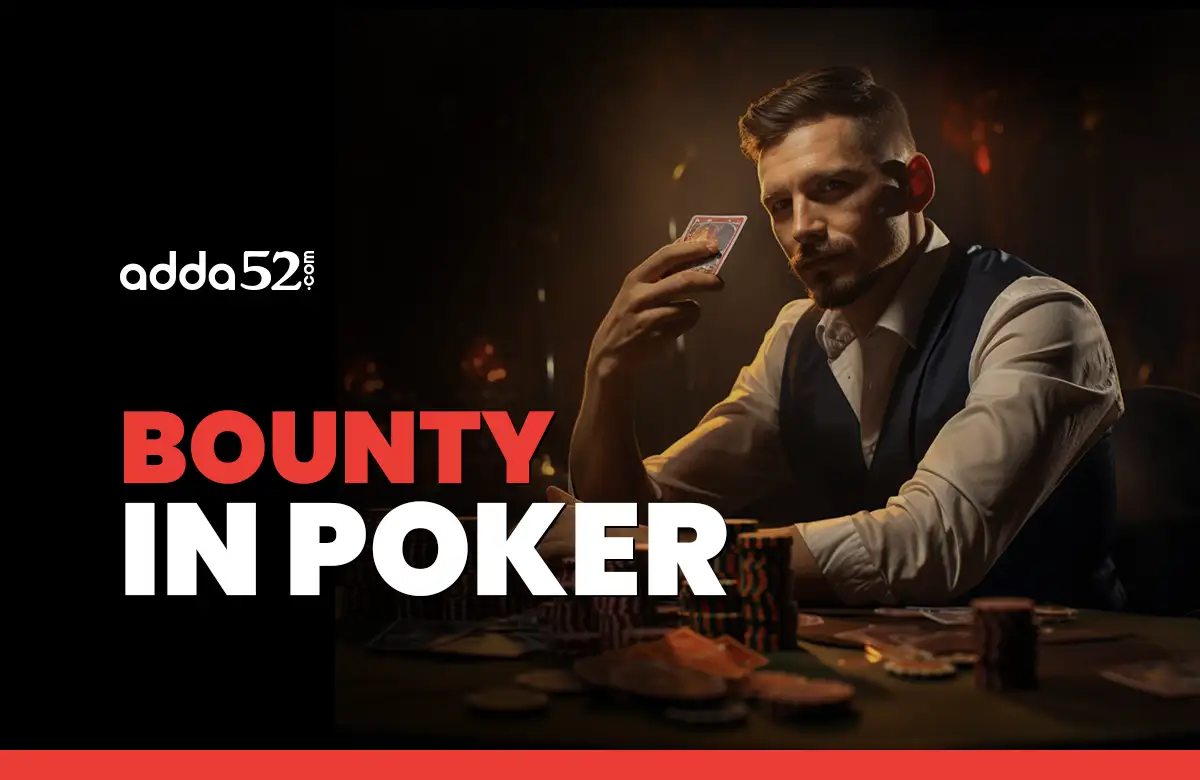
Introduction
Poker offers a range of formats to spice up the traditional playstyle, and one such variation is the Bounty Tournament. A bounty adds a twist to regular Poker tournaments, allowing players to earn additional rewards for eliminating opponents.
In this article, we will explore the concept of bounty in the card game.
Bounty in Poker
A bounty is a monetary prize given to a player for eliminating an opponent during a tournament. This format encourages participants to concentrate on knocking out other players for instant rewards while competing for the main prize pool. Due to their exciting nature, bounty tournaments are widely favoured in live and online Poker.
How Does a Bounty Tournament Work?
In Poker bounty tournaments, every player carries a bounty value linked to them, representing part of their buy-in. When you knock out an opponent, you earn their bounty. This means you can start earning money before reaching the prize-paying stages of the tournament.
Example:
If the tournament has a ₹1,000 buy-in:
₹500 might go to the main prize pool.
₹500 becomes the player's bounty.
If you eliminate a player, you instantly claim ₹500 as a reward.
Types of Poker Bounty Tournaments
There are various bounty formats, each with unique features:
-
Fixed Bounty Tournaments
A fixed amount is assigned as a bounty for each player.
When you eliminate a player, you claim their full bounty.
Example: If each player’s bounty is ₹500, eliminating three players earns you ₹1,500.
-
Progressive Knockout (PKO) Tournaments
In the most popular bounty format, only a portion of a player’s bounty is awarded to you, while the remaining portion is added to your own bounty. This makes you a more attractive target as the game progresses.
Example: If a player’s bounty is ₹1,000, you might claim ₹500, and the other ₹500 is added to your bounty. After the elimination, your bounty increases, making you a lucrative target for others.
-
Super Knockout Tournaments
A larger share of the buy-in is allocated to the bounty pool in these tournaments. Often, 50% or more of the buy-in contributes to the bounties.
-
Mystery Bounty Tournaments
A newer format where bounties are randomly assigned different values and are revealed only after a player is eliminated. Some bounties might be small, while others could represent a big chunk of the prize pool, creating unpredictability and excitement.
Strategy for a Bounty Poker Tournament
Bounty tournaments require a mix of regular tournament strategy and bounty-focused adjustments:
-
Targeting Short Stacks
Short-stacked players are easier to eliminate and often carry valuable bounties. Use aggression strategically to isolate and knock them out.
-
Aggressive Play with Strong Hands
Opponents chasing bounties tend to call wider ranges. Play aggressively when you have a strong hand to extract maximum value.
-
Avoiding Reckless Chases
While chasing bounties is tempting, avoid taking unnecessary risks that might jeopardize your stack. Balance aggression with survival.
-
Defending Your Bounty
Opponents may target you if your bounty becomes large (especially in PKO formats). Avoid putting yourself in marginal situations where you risk elimination.
-
Position Awareness
Use your position to control the action, especially when targeting opponents with significant bounties. Positional play can help you make better decisions.
Reasons to Participate in Bounty Poker Tournaments
-
Immediate Earning Potential
Unlike traditional tournaments, where players need to reach the payout stages to earn money, bounty tournaments allow participants to start earning by eliminating opponents. Every knockout rewards the eliminator with the opponent’s bounty, making it possible to recover or exceed the buy-in even before reaching the money.
Example:
In a ₹2,000 buy-in bounty tournament, if ₹1,000 is allocated to bounties, knocking out two players earns you ₹2,000, effectively covering your entry fee.
-
Increased Action and Aggression
Bounty tournaments naturally encourage more aggressive gameplay, as players are incentivized to chase knockouts. This leads to more action-packed hands and frequent all-ins, making the tournament exciting for everyone involved.
-
Strategic Decision Making
The dual focus on bounties and the main prize pool complicates bounty tournaments. Players need to balance carefully:
- Chasing bounties to maximize short-term earnings.
- Preserving their stack for long-term tournament success.
-
Chance to Profit Without Reaching the Prize Pool
In regular tournaments, players must survive until the money bubble to secure any profit. In bounty tournaments, earning bounties along the way can result in profits even if a player doesn't reach the payout stages of the main prize pool.
Example:
If you win ₹5,000 in bounties by eliminating opponents but don’t finish in the prize pool, you still walk away with cash, unlike in standard tournaments.
-
Fun Gameplay
Bounty tournaments keep players engaged by adding an additional goal: hunting bounties. The thrill of knocking out opponents and collecting rewards creates a fun, competitive atmosphere, appealing to recreational players who enjoy fast-paced action.
-
Bigger Rewards in Progressive Formats
Progressive Knockout (PKO) tournaments amplify the excitement as bounties grow larger with each elimination. This format ensures escalating rewards, making deep runs in the tournament even more lucrative.
Example:
If a player with a ₹5,000 bounty is knocked out, you might win ₹2,500 immediately, while the other ₹2,500 is added to your own bounty, making you an even more valuable target.
-
Better Value for Recreational Players
For casual players, bounty tournaments provide better value by offering multiple ways to win. Even if players don’t place in the prize pool, they can still enjoy the satisfaction of earning bounties and playing aggressively.
-
Attracts Varied Skill Levels
Bounty tournaments attract a blend of recreational and professional players, creating opportunities for skilled individuals to exploit the mistakes made by less experienced opponents who may recklessly pursue bounties.
-
Promotes Taking Risks
The bounty format motivates players to take calculated risks, creating an exhilarating experience. In contrast, traditional tournaments usually see participants adopting cautious strategies to survive until they reach the money bubble.
-
Captivating Final Table Play
At the final table, bounties can be as valuable as the prize pool. This generates a high-stakes atmosphere where players must handle aggressive opponents while balancing their survival with maximizing bounty earnings.
Frequently Asked Questions
What does a bounty mean in Poker?
In a bounty tournament, each player has an associated cash prize known as a bounty. Eliminating an opponent allows you to collect their bounty and instantly boost your winnings. These tournaments merge standard prize pools with knockout rewards, increasing potential payouts throughout the competition.
How do Progressive Knockout (PKO) tournaments work?
In PKO tournaments, only part of their bounty goes to the eliminator when a player is eliminated. The remainder boosts the eliminator's own bounty. As the tournament advances, bounties increase in size, making it more appealing for players to eliminate opponents.
What is the difference between a regular and a bounty tournament?
In regular tournaments, all earnings come from the prize pool, while in bounty tournaments, players earn cash rewards for eliminating opponents. This allows for potential profits before reaching the prize-paying stages.
Conclusion
Understanding how to balance aggression and survival is key to success in the bounty tournament poker format. With the potential to earn immediate rewards and the thrill of hunting big bounties, this format offers a unique and rewarding experience for Poker enthusiasts.
